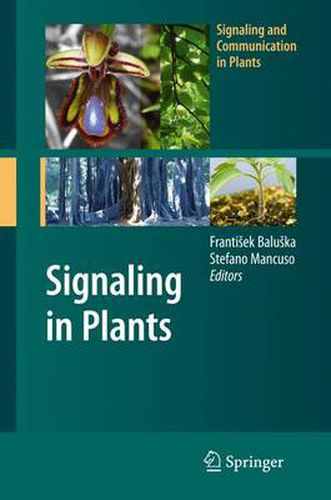Readings Newsletter
Become a Readings Member to make your shopping experience even easier.
Sign in or sign up for free!
You’re not far away from qualifying for FREE standard shipping within Australia
You’ve qualified for FREE standard shipping within Australia
The cart is loading…






This title is printed to order. This book may have been self-published. If so, we cannot guarantee the quality of the content. In the main most books will have gone through the editing process however some may not. We therefore suggest that you be aware of this before ordering this book. If in doubt check either the author or publisher’s details as we are unable to accept any returns unless they are faulty. Please contact us if you have any questions.
Plants are unique as their development and morphogenesis are plastic throughout their lives. They continuously monitor diverse biotic and abiotic parameters of their environment and these sensory perceptions shape their organs and bodies. Although genes are critical, the final form and architecture of above-ground organs, and es- cially of root systems, are determined by their sensory activities associated with motoric responses (Friml 2003; Hodge 2009). Sensory plant biology and plant el- trophysiology were two lively disciplines until the late 1970s (Bunning 1959; Haupt and Feinleib 1979) but then, for somewhat obscure reasons, they showed no further development. In the last few years, however, there have been numerous advances in plant sciences. These necessitate not just a revival of plant electrophysiology and sensory biology, but also the introduction of plant neurobiology, which includes also plant sensory ecology (Baluska et al. 2006a; Brenner et al. 2006). First of all, and contrary to all mechanistic predictions based on the high turgor pressure of plant cells, endocytosis has been found to be an essential process of plant cells which impinges upon almost all aspects of plant life (Samaj et al. 2005, 2006). Moreover, recent advances in plant molecular biology have identified, besides classic n- rotransmitters, also several proteins typical of animal neuronal systems, such as acetylcholine esterases, glutamate receptors, GABA receptors, and endocannabinoid signaling components, as well as indicating signaling roles for ATP, NO, and re- tive oxygen species (Baluska et al. 2006b).
$9.00 standard shipping within Australia
FREE standard shipping within Australia for orders over $100.00
Express & International shipping calculated at checkout
This title is printed to order. This book may have been self-published. If so, we cannot guarantee the quality of the content. In the main most books will have gone through the editing process however some may not. We therefore suggest that you be aware of this before ordering this book. If in doubt check either the author or publisher’s details as we are unable to accept any returns unless they are faulty. Please contact us if you have any questions.
Plants are unique as their development and morphogenesis are plastic throughout their lives. They continuously monitor diverse biotic and abiotic parameters of their environment and these sensory perceptions shape their organs and bodies. Although genes are critical, the final form and architecture of above-ground organs, and es- cially of root systems, are determined by their sensory activities associated with motoric responses (Friml 2003; Hodge 2009). Sensory plant biology and plant el- trophysiology were two lively disciplines until the late 1970s (Bunning 1959; Haupt and Feinleib 1979) but then, for somewhat obscure reasons, they showed no further development. In the last few years, however, there have been numerous advances in plant sciences. These necessitate not just a revival of plant electrophysiology and sensory biology, but also the introduction of plant neurobiology, which includes also plant sensory ecology (Baluska et al. 2006a; Brenner et al. 2006). First of all, and contrary to all mechanistic predictions based on the high turgor pressure of plant cells, endocytosis has been found to be an essential process of plant cells which impinges upon almost all aspects of plant life (Samaj et al. 2005, 2006). Moreover, recent advances in plant molecular biology have identified, besides classic n- rotransmitters, also several proteins typical of animal neuronal systems, such as acetylcholine esterases, glutamate receptors, GABA receptors, and endocannabinoid signaling components, as well as indicating signaling roles for ATP, NO, and re- tive oxygen species (Baluska et al. 2006b).